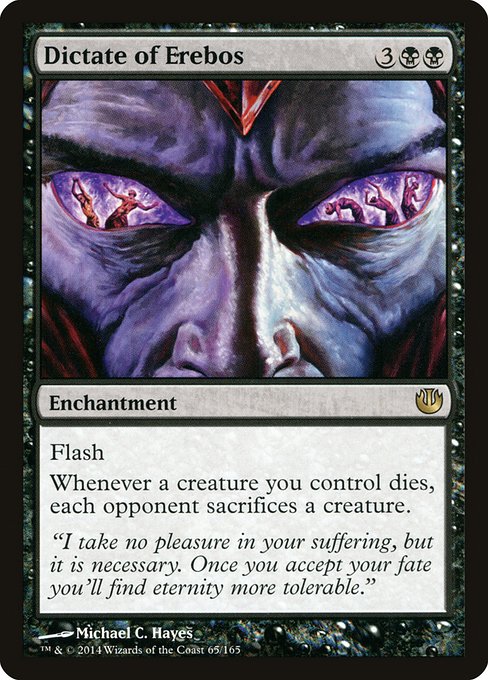
Image courtesy of Scryfall.com
The Evolution of Enchantment Design
Magic’s enchantments have always been the glue that lets a plan breathe, or sometimes snap shut like a coffin lid. In a game that dances between tempo, value, and flavor, a black enchantment from Journey into Nyx stands out as a clear marker of how design has evolved: a single, elegant condition that scales with the board and swallows a chunk of the opponent’s options. This particular piece embodies a shift toward tempo-driven, surprise-action enchantments that punish opponents for common battlefield outcomes — creatures dying — while staying true to black’s love affair with death, sacrifice, and inevitability 🧙♂️🔥💎⚔️.
A Flashy Foundation: The Power of Surprise
At its core, the card arrives with Flash, so you can cast it at instant speed and catch opponents off guard during combat or after they think they’ve stabilized. That capability reframes the timing window on enchantments: no longer merely a slow, recurring effect, but a weapon you can deploy at the moment your foe commits to a plan. The inclusion of flash is a design choice that pays off in multiplayer environments too, where timing is everything and a sudden threat can redirect a whole table’s strategy 🧙♂️🎲.
Death Triggers as a Design North Star
The Oracle text — "Whenever a creature you control dies, each opponent sacrifices a creature of their choice" — does a lot with a modest line of text. It rewards a board that can absorb losses while turning those losses into value for you and pain for everyone else. This is a quintessentially black mechanic: making a tough space feel even tougher by turning the tide on death into strategic concessions from opponents. It’s not just about raw power; it’s about shaping the game’s flow. The design invites echoing synergies with sacrifice-themed decks (often called Aristocrats) and even loops with ETB/death catalysts, where one creature’s sacrifice sparks a cascade of strategic decisions. The result is a card that ages gracefully as players refine ways to leverage demise into advantage 🧙♂️💥.
“I take no pleasure in your suffering, but it is necessary. Once you accept your fate you’ll find eternity more tolerable.”
That flavor text anchors the card in Nyx’s mythic mood, underscoring the inevitability that accompanies black enchantments. Thematically, it locks you into a universe where death itself becomes leverage, and the art direction by Michael C. Hayes visually reinforces the sense of a grim oracle watching over a battlefield that’s never truly safe. The elegance of the card’s design lies in its clarity: one line, two colorless costs, and a single, devastating trigger that compounds as the game evolves 🔥🎨.
From Rarity to Relevance: Collectibility and Modern Play
As a rare from Journey into Nyx, this enchantment has held a distinct footprint in both Commander and standard modern-legal formats. Its foil variant and nonfoil printings offer a spectrum of value that mirrors its mid-tier but steady utility in many black-based shells. The card sits comfortably in the EDH/Commander environment where flash plus a duel-sided response can lock down a turn or two and tilt a whole game. Prices and demand ebb and flow with the health of Aristocrats-and-control hybrids, but its role as a design milestone remains constant: it codifies a philosophy where enchantments can be aggressively interactive without demanding built-in card draw or fetch lands to shine. In a collectible sense, it’s a compact snapshot of a design era that prioritized tempo and inevitability over splashy, "do-everything" effects 🧙♂️⚔️.
Flavor, Theme, and the Craft of Enchantment Design
Lore and flavor are not mere window dressing here. The card’s dark allure sits at the intersection of underworld lore and mechanical discipline. The idea that you’re fighting not just one creature but the table’s collective action — “each opponent sacrifices a creature of their choice” — elevates the enchantment from a personal tool to a strategic pivot point for multiplayer games. The Journey into Nyx setting emphasizes mythic gravity, and this card’s design carries that weight into the kitchen-table meta. The art and keyword text work in tandem to communicate a world where the mere whisper of a shadow can decide who plays next 🧙♂️🎲.
- Tempo with Flash: Providing a credible reason to cast enchantments at instant speed expands strategic options beyond the old “play on turn three and hope for the best.”
- Die Triggers That Scale: Tying a condition to your own creatures dying invites robust interactions with sacrifice and token strategies, while remaining approachable for new players.
- Single-Card Space, Big Impact: A compact effect can shape the entire endgame if it’s well-timed and clearly worded, which keeps puzzle-solving manageable for players of all levels 🔥.
- Flavor-Mechanic Alignment: Thematic resonance—death, fate, underworld bargains—elevates the feel of the card beyond the numbers on the back of the card.
For contemporaries building around black sacrifice, this card offers a reliable political lever: it can seed creature-sack tempo while leaving you with a strong board presence. It rewards careful play, and the potential to cripple multiple opponents on a single trigger makes it a staple in certain decks that like to stretch a game longer, trading inevitability for servant-like control of the battlefield. And in casual circles, it’s the kind of card that prompts lively debates: who chooses the sacrifices, how many, and when is the best moment to press the pedal? The conversation around it is part of the enchantment’s enduring charm 🧙♂️💎⚔️.
Curious minds building modern, legacy, or commander lists might also swing by hands-on sources to explore copies in foil or non-foil variations. While you’re deep-diving into the mechanics of this piece, you can peruse related gear that makes game nights smoother—like this handy gadget designed to keep your phone steady while you study decklists or stream matches. A small, tactile companion can make long nights more comfortable as you climb the ladder of challenge.